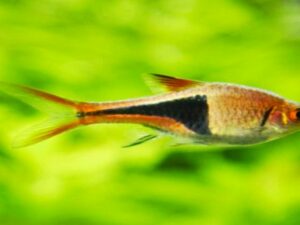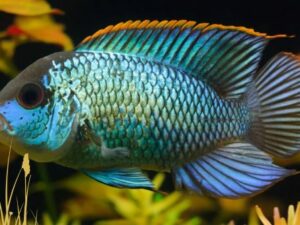The Firemouth Cichlid, scientifically known as Thorichthys meeki, is one of the most popular cichlids in pet stores. This fish has a large body, bold coloration, and an aggressive temperament.
However, it’s not only the Firemouth Cichlid’s looks that have made it so popular. It is also easy to breed in home aquariums with proper care. The Firemouth is considered a moderately difficult fish to care for because it requires a lot of space and proper conditions in which they can thrive.
Let’s get to know more about the Firemouth Cichlid.
Table of Contents
Facts And Characteristics Of Firemouth Cichlid
Given below are a few facts and characteristics of the firemouth cichlid. Let’s have a look at all the important characteristics of the firemouth cichlids.
Appearance
The Firemouth Cichlid is an oval-shaped, laterally compressed fish. The males are known to have large mouths that resemble a “fire” or “bulldog” appearance.
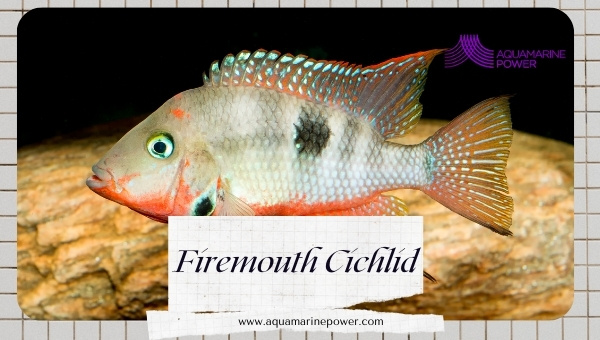
Their body colors range from reddish hues with dark spots, vertical bars, and sometimes faint horizontal stripes. They are not always this colorful, though, as they can vary in shades of brown, orange, and yellow.
Females are usually a light brown color with bluish-green vertical bars and silver specks throughout the body. Their dorsal fin is pointed in males but rounded in females. Males have longer fins than their female counterparts, including their pectoral fins, anal fin, and caudal peduncle.
Both genders have a horizontal black stripe on their sides that has either light brown or gray sections between the bands. The caudal fin is usually yellowish-brown with reddish/orange tips and is sometimes hard to see, depending on how dark the body color is.
Their eyes are bright red, and they have a small black patch on their gill cover (operculum). Males can grow up to 10 inches long, while females will stay smaller at around 6 inches.
The appearance of the Firemouth Cichlid is very similar to the Red Empress Cichlid, but theirs has a more yellow and blue color.
Temperament Of Firemouth Cichlid
The Firemouths tend to be aggressive but not overly so. They are mostly territorial with their species and could become very violent if they feel that there is a threat from another fish.
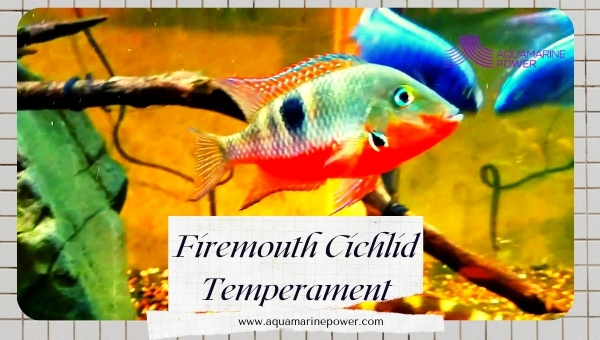
In the aquarium, it is best to have one male with several females because males can be quite mean towards other male Firemouths. Males will sometimes display their aggression towards other fish by facing them with their mouths open and pushing themselves backward.
A good amount of space should be provided to ensure that potential enemies are far apart from one another. If given enough living space, Firemouths can make very good community fish while they are young and will not always behave aggressively towards other species.
As they grow, they will start to exhibit their natural territorial behavior and should be kept in a species-only aquarium.
Read: Red Devil Cichlid 101: Best Detailed Care Guide
Habitat Of Firemouth Cichlid
Firemouths are endemic to Mexico and Central America. You can find them near rivers and streams in shallow waters with sandy or gravel bottoms, so it will be best to recreate that environment if you want to keep your Firemouth healthy and happy.
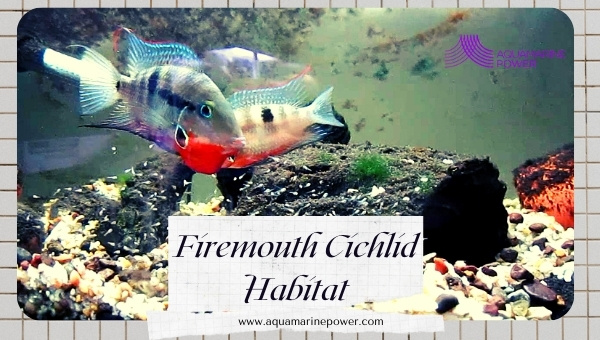
They like habitat with some vegetation and rocks, so if you wanted to make your Firemouth happy, you could try adding manzanita branches, driftwood, slate, smooth flat rocks, artificial bogwood, aquatic low light plants like Cryptocoryne or Anubias barteri ‘narrow leaf’, and other decorations the will fit in its mouth.
Average Lifespan And Growth Of Firemouth Cichlids
The average lifespan of a Firemouth is about ten years, but if they receive the proper care and the correct diet, then you should experience no problems.
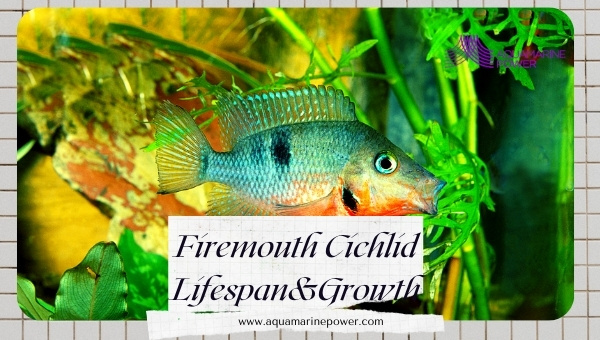
If you provide your Firemouth with a proper diet and the correct care, they should grow to about nine inches in length. They will weigh around 2-3 pounds when they are fully grown, which should take about 5 years. They are sexually dimorphic, with a clear distinction between males and females.
Males are known to be more slender than females of similar size, but this is something that can only be truly seen when they are spawning or engaging.
Breeding
A male and female will typically form a breeding pair. After the mating ritual, which can last up to fifteen minutes, the female Firemouth will start to build a nest out of the rubble.
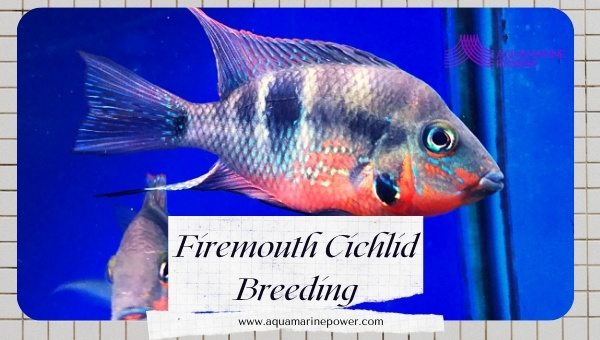
For her to feel comfortable enough to lay her eggs, she would have to have at least 4-5 inches of substrate in an established tank with plenty of hiding places. She will deposit the eggs onto the substrate, and after fertilization, she will dig a hole to bury them.
After the spawning process is complete, the fry takes about six weeks to become free-swimming. It would be best if only one Firemouth was kept in an aquarium, so it does not eat its babies during this period.
Once the fry is free-swimming, they will start to look for food in the form of brine shrimp nauplii or any other small food items like bloodworms that you can feed them.
Please be aware that Firemouth Cichlids are mouthbrooders, meaning the male will care for the fry in his mouth until they are large enough to be on their own.
You should not combine male Cichlids with other male Cichlids after spawning because if your male kept spawns with another male Firemouth, then both males will want to care for the fry, and there is only room for so many mouths inside of a cichlid’s mouth. If you don’t believe me ask my dad.
Read: Peacock Cichlid 101: Facts, Characteristics & Care Guide
Firemouth Cichlids Care Guide
Some ways to keep your Firemouth Cichlids healthy and disease-free are as follows:
Tank Requirements
A minimum of 30 gallons is required to keep this species because they do grow quite large over time. If you are just starting with a relatively small tank, you can get away with having a male and two females in the tank.
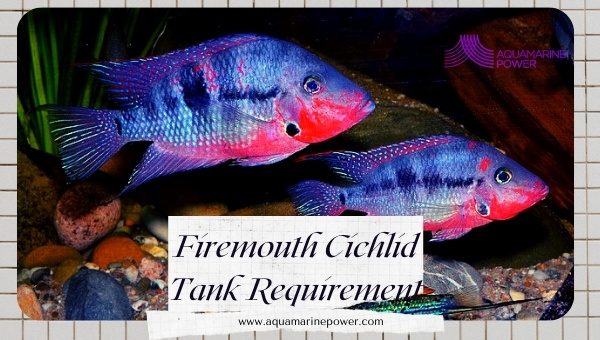
However, in time, they will require more space because males will become increasingly hostile towards one another as they get older. A 30-gallon long acrylic fish tank is best for keeping three Firemouths together, but if you have a larger aquarium, then keeping 4-6 of them is recommended.
In the wild, Firemouths are known to travel long distances from one location to another in search of food or shelter. In an aquarium setting, it is recommended that you create similar conditions for your fish by hiding the filter outflow with rocks or roots.
This will provide natural hiding spots for them to feel more secure. When they are comfortable in their new environment, they will start exploring the entire tank instead of just staying in one spot.
The filtration should provide the tank with a strong current because of Firemouths like highly oxygenated and clean water. This will make it easier to maintain good water quality and reduce nitrates which can be harmful to your fish.
They are not very picky when it comes to filtration, but any external power filter or internal power filter would be suitable choices. If you have a pump system in your tank, then that is even better because it will provide the best filtration possible for your aquarium.
Water Condition And Lighting
Firemouths prefer soft, acidic water because it more closely resembles the waters that they are native to. The ph level should be around 6.5, and the DH should be as close as 0 as possible.
Low hardness is preferred because they are Central American Cichlids that originated from waters with very soft water conditions. Low alkalinity is important as well since their native waters tend to have high acidity levels, which are best replicated through low KH/GH systems.
Your main priority is to make sure that the pH level of your aquarium stays around 7.0. It will make them very comfortable and happy as long as there are no rapid changes in pH levels (meaning multiple changes in one day).
You should also monitor the temperature of the tank because it should stay between 73-81 degrees Fahrenheit. If they are kept in water that is too cold, their metabolism will slow down, so they won’t be able to eat very much.
On the other hand, if they are kept in too hot water, your female will be less likely to spawn, and the eggs might not hatch.
When it comes to lighting, make sure that you choose a light that is not too strong or too dim. Not having enough lighting will cause your Firemouths to become stressed and very uncomfortable.
But if they are exposed to extremely bright lights, then their eyesight will be damaged, and they might start having problems finding food or eating altogether.
Feeding
Firemouth Cichlids are omnivores and will feed on a wide variety of foods in the wild. In an aquarium setting, they can be fed any flake or pellet food that floats at the water’s surface.
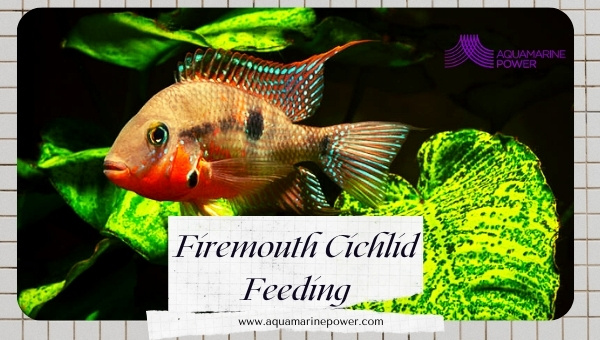
Supplementing their diet with brine shrimp, bloodworms, or even insects like crickets will encourage them to eat and make for a happier, healthier fish. The Firemouth Cichlids are primarily piscivorous, which means they eat a lot of fish.
You should offer them a varied diet that will include Beefheart as well as brine shrimp and bloodworms. Try to mimic their natural diet to make them even more comfortable in your aquarium.
You can do this by offering them feeder fish and livebearer fry since they both make up a large portion of their natural diet.
If you offer them feeder fish and livebearer fry regularly, then there is no need for you to feed them any other type of food. However, if you only offer them feeder fish and not livebearer fry, then you should supplement their diet with brine shrimp or bloodworms.
If you are looking to breed Firemouths, then you should consider changing their diet. Live food is recommended to successfully spawn this species because it entices the females into spawning more than they usually would.
They can be fed frozen brine shrimp, bloodworms, or live blackworms. Firemouths will not necessarily eat the eggs that are laid after spawning if they are well fed during the breeding process.
Tankmates
Even if they are aggressive towards other Firemouths, it is best to keep them with other Central American Cichlids so they can establish their territories instead of fighting for dominance amongst themselves.
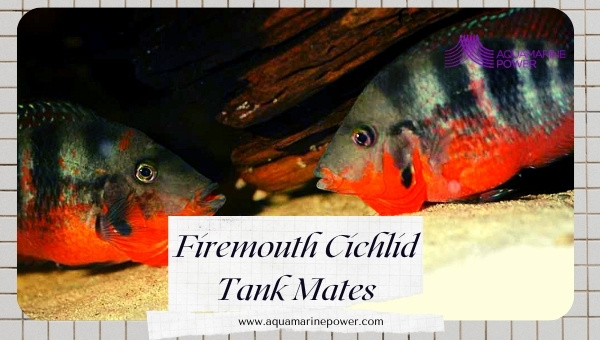
Other Central American Cichlids that you could potentially put in the aquarium include Convicts, Jack Dempseys, Jaguar Cichlids, and Midas Cichlids.
The Convicts and Jack Dempseys have different care requirements but will do fine in the same aquarium as a Firemouth because they are not as aggressive.
50 gallon or larger tank would be best if you wanted to house those species together since they grow quite large and can become territorial as they get older.
You can keep a Firemouth in a community tank with fish that share similar water requirements and temperament. Anything from other Central American Cichlid species to Rainbowfish can be kept in the same tank as your Firemouth.
If you don’t want to keep them with another cichlid, there is an alternative option. If you want to add more colors to your tank, you can add a variety of tetras as long as they are not small enough to fit in the Firemouth’s mouth.
Tetras like the Rummy nose Tetra, Ruby Tetra, and Sliver tip tetra make good tank mates. Other fish that would look great with a Firemouth include Oscars, Goldfish, Angelfish, Bala Sharks, Discus, and Angelfish.
Equipments Required
Your Firemouth Cichlid will need a large tank, so they have enough room to swim, but you also have to make sure that your filtration is powerful enough to keep up with the demand of having this many fish inside your aquarium.
Having a lot of decorations and hiding places in your aquarium can help them feel more comfortable and secure, so they can show their natural behaviors.
This will also add to the beauty of your aquarium and make it a more interesting place for you and other people who come over to visit.
Aquascaping
Aquascaping the Firemouth’s tank is very important because it will set the mood and create a specific look for your aquarium.
The substrate of the tank should be made out of gravel which has small to medium-sized grains. Sand, by comparison, can harm their mouths if they try eating it, so avoid using sand as a substrate in your aquarium.
Caves are always a good idea for Firemouths because they will feel safer in them and breed more frequently. Rocks, plants, driftwood, and flowerpots can all be used to create cave-like hiding places for your fish so they can feel secure and happy during the day.
Plants might not provide as much cover as rocks do, but they will help with water movement and provide extra cover for your fish. It is also an aesthetic choice that can add to the appearance of your aquarium.
Make sure to choose tropical plants that are suitable for aquariums because some plants can quickly take over your tank if you let them.
Common Possible Diseases And Their Cures
As with all fish, you have to be aware of the possibility of diseases. But most notably for Firemouth Cichlids will be hole-in-head disease, ich, and fin rot.
Hole in head disease is a bacterial infection that causes lesions to appear on their faces which then grow into deep holes.
One of the first signs of this disease is a loss of appetite, and the beginning stages can be treated with Melafix or Pimafix. However, if left untreated, it could kill your fish.
Ich is caused by parasites that invade their gills and cause them to become inflamed as their bodies try to fight off the attack. This will result in your fish scratching against rocks and tank decorations to try and get relief from the irritation.
The best treatments for this disease are salt and copper because they will destroy the parasites without harming your Firemouth Cichlids.
Fin rot is a bacterial infection that causes fins to become red and inflamed, and if left untreated, it could spread throughout your fish’s body and kill them.
Treating this disease is very similar to treating ich because the main ingredients are salt and copper.
Many other illnesses can affect Firemouth Cichlids, but these are the most common ones you need to be aware of when owning one.
The best way to avoid getting your fish sick is through prevention, so make sure to quarantine any new fish before introducing them to your main tank.
Conclusion
Firemouth Cichlids are a great choice for beginner fish keepers because they stay on the smaller side and can survive in a wide range of conditions. They also have striking colors, which makes them a beautiful addition to any aquarium.
However, you should choose tank mates wisely because not every fish will get along with them. These characteristics make Firemouth Cichlids one of the best first fish to own.
Thank you for reading.


